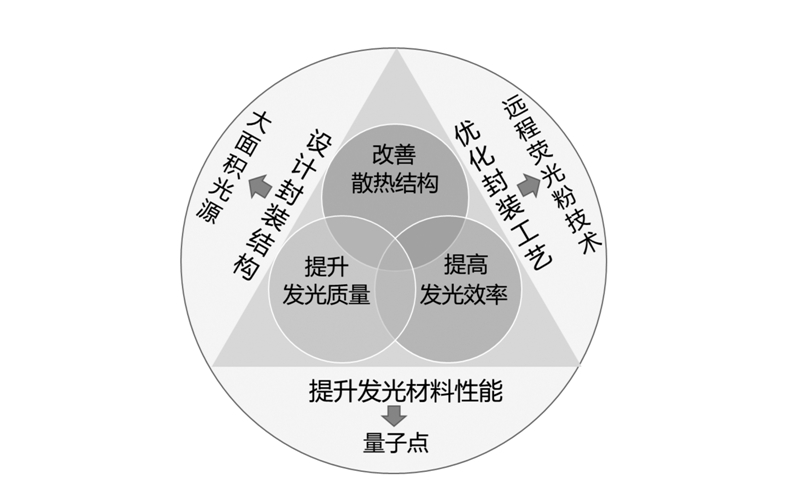Remote phosphor technology for white LED applications:advances and prospects
-
摘要: 远程荧光粉技术通过将荧光粉与芯片分离,降低了荧光粉的工作环境温度,提升了荧光粉的稳定性,改善了白光LED的照明品质和光效,同时有望降低LED眩晕度,提供大面积平板光源,在未来照明与显示应用中具有重要意义。远程荧光粉技术的白光LED将向多功能化、高性能化和智能化方向发展。本文将综述白光LED远程荧光粉技术的研究进展,主要介绍其封装工艺的优化、评价参数的构建和分析,以及相关荧光材料的发展现状。Abstract: Remote phosphor technology for white LEDs provides new encapsulation construction, which separates the blue chip and color converting materials at a large distance. This technology could potentially reduce the working temperature of phosphors and solve the thermal quenching problems and enable us to fabricate flat panel lighting source with enhanced lighting quality. Therefore, remote phosphor technology has drawn a great of attentions from both of the scientific and industrial communities. White LED applications with remote phosphor technology will be further developed into be more functional, high-performance and intelligent. In this review, we summarize the recent advances in remote phosphor technology for white LED with emphasis on the encapsulation structures, devices evaluation as well as the novel down conversion materials. The prospects of remote phosphor technology are also presented.
-
Key words:
- remote phosphor technology /
- white LED /
- encapsulation technics /
- fluorescent materials /
- quantum dots
-
图 3 (a)Ce∶YAG荧光粉用有机树脂[12]和玻璃陶瓷作为基质制作的发光片;(b)两种基质的Ce∶YAG荧光粉发光片的热稳定性对比[22]
Figure 3. (a)Photographs of Ce∶YAG glass ceramic[22] and Ce∶YAG phosphor dispersed in organic-resin[12]. (b)The relative PL intensities of Ce∶YAG glass ceramic and Ce∶YAG phosphor dispersed in organic-resin in the temperature range of 25~200 ℃[22]
图 4 (a)远程荧光粉技术白光LED中3种不同的外封装胶形状[29];(b)使用一层很薄的封装胶进行隔离的双层荧光粉结构示意图[32];(c)采用不同厚度的曲面远程荧光粉形状优化白光LED发光均匀性[35];(d)“倒锥形”的远程荧光粉技术结构示意图[43]
Figure 4. Schematic cross-sectional view of different encapsulation shapes. (a)Three different geometries of the encapsulation dome[24]; (b)dual-layer remote phosphor structures[32]; (c)optimized phosphor layer with ellipsoidal surface[35]; (d)ring-remote phosphor structure[43]
表 1 稀土荧光粉与量子点荧光材料对比
Table 1. Comparisons between rare earth phosphors and quantum dot materials
-
[1] [2] [3] [4] [5] [6] [7] [8] [9] [10] [11] [12] [13] [14] [15] [16] [17] [18] [19] [20] [21] [22] [23] [24] [25] [26] [27] [28] [29] [30] [31] [32] [33] [34] [35] [36] [37] [38] [39] [40] [41] [42] [43] [44] [45] [46] [47] [48] [49] [50] [51] [52] [53] [54] [55] [56] [57] [58] [59] [60] [61] [62] [63] [64] [65] [66] [67] [68] [69] [70] [71] [72] [73] [74] [75] [76] [77] [78] [79] [80] [81] [82] [83] [84] [85] [86] [87] [88] [89] [90] [91] [92] [93] [94] [95] [96] [97] [98] [99] [100] -






 下载:
下载:








